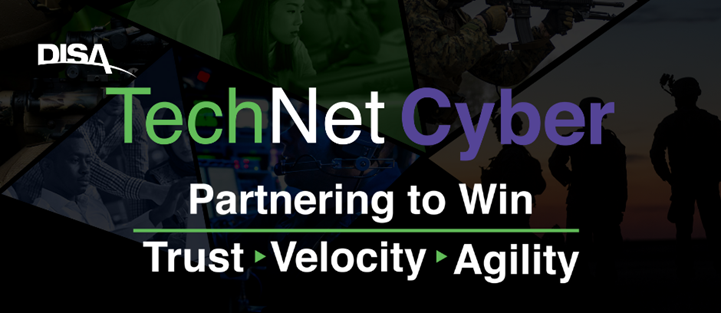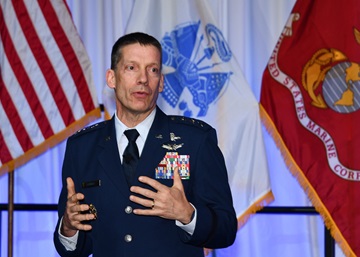DISA reaches thousands at TechNet Cyber and leads a shift in cyber solutions
By Michael Ugarte
Media Relations Branch
DISA Office of Strategic Communication and Public Affairs
May 11, 2022

Nearly 4,700 attendees and over 300 cyber-industry vendors across the Department of Defense, private industry and academia descended upon the Baltimore Convention Center in Maryland, for the 2022 TechNet Cyber conference April 26-28, to promote Defense Information Systems Agency innovation and strategic partnerships.
The annual conference, co-hosted by DISA and the Armed Forces Communications and Electronics Association, AFCEA, served as a professional forum and catalyst for cyber- and information technology-focused professionals in support of the U.S. and allied partners. The conference featured 132 moderated panel-driven sessions containing cyber professionals from DISA and industry partners.
 |
| Air Force Lt. Gen. Robert J. Skinner provides the keynote address during the 2022 AFCEA TechNet Cyber conference in Baltimore, Maryland, April 26, 2022. The conference works as a staging area for military, industry and academia to discuss and plan how to achieve persistent engagement, persistent presence and innovation. (U.S. DOD photo by Thomas L. Burton, DISA/Released) |
This year’s conference theme was Partnering to Win – Trust, Velocity, Agility and kicked off with a keynote address by U.S. Air Force Lt. Gen. Robert J. Skinner, DISA director and Joint Force Headquarters-Department of Defense Information Network commander.
"Every great invention begins with someone asking the question, ’Wouldn't it be cool if …,'" Skinner said.
Skinner posed his actionable question to the audience to prompt a shift in how challenges are approached and overcome, and new solutions developed for the benefit of DISA’s customers - joint warfighters, national-level leaders and other mission and coalition partners across the full spectrum of military operations.
Principles of Command and Control
Command and control, or C2, ensures every element within an organization has a clear understanding of visions and roles across all desired outcomes. During the conference, subject matter experts discussed the necessary actions, information exchange, and synchronization to effectively secure, operate and defend the DODIN.
“We have tools, but how can we work together to leverage them? Allowing us to better serve our nation,” said Don Means Jr., DISA's Operations and Infrastructure Center director.
A lack of common data streams is a concern for the agency, which can cause delays in analytical data gathering and intelligence analysis, added U.S. Navy Capt. John “Rick” Larson Jr., DISA’s Joint Operations Center commander.
With his sights set on the future, U.S. Army Col. Kevin M. MacNeil, director of operations, J-3, JFHQ-DODIN, asked, “Wouldn't it be cool if we had self-healing systems that utilized artificial intelligence instead of relying on [human] technicians? Allowing technicians to focus on those [issues] far too complex for artificial intelligence to resolve. Some things require that human touch."
Joint All-Domain Command and Control
Joint All-Domain Command & Control, or JADC2, is one of the many ongoing collaboration initiatives aimed at reducing complexity to streamline cyber operations across DOD. "Data is the blood that makes JADC2 work," said U.S. Army Col. Kevin Finch, deputy director for Acquisition, Digital Capabilities and Security Center and DISA’s JADC2 lead.
DISA supports many areas related to C2, including capability modernization, electromagnetic spectrum, data and common-architecture initiatives. Through JADC2, decision-makers will have a wide-span view of an operations landscape.
“Taking what we are doing now using a legacy network, inject the ‘wouldn’t-it-be-cool-if,’ and take the network to the next level,” said Caroline Kuharske, acting director for DISA’s Office of the Chief Data Officer, as she walked through JADC2 concepts with the audience.
Kuharske outlined the agency's responsibilities, which include data hosting, network transport and spectrum access, that provide military commanders and government leaders the information they require – “wherever and whenever it is needed.”
The industry will need to move beyond proprietary services and capabilities to mesh a range of capabilities in support of a unified outcome, added Finch.
“The goal here is to develop the joint network of the future, today,” said Dickey Rounsaville, DISA transport plans branch chief.
Thunderdome Zero Trust
DISA’s Thunderdome Zero Trust pilot seeks to implement a zero-trust security model at the enterprise level to enhance network architecture, network security and performance. Zero trust assumes the network is already compromised and is a process that validates the user, device, application and data in a controlled manner.
"We [DISA] are in the process of standing up capabilities laboratory environment before testing in fielded networks,” said Dr. Brian Hermann, director of the Cybersecurity and Analytics Directorate.
“We're going to test it at the Pentagon. We're going to test it at Fort Meade, [Maryland] and we're looking at another location — maybe another collaboration with a different service as part of that as well,” Hermann said as he responded to an inquiry related to the Thunderdome pilot.
In keeping with Skinner’s 'Wouldn't it be cool if …'" mantra, Jason Martin, DISA’s Digital Capabilities and Security Center director, discussed the use of Other Transaction Authority agreements, or OTA, for the Zero Trust pilot. An OTA cuts through federal red tape while aiding agencies in adopting technology at a faster pace.
“We’re moving forward - sitting down with the vendor on a daily basis to work through where are we going to go when, what are the milestones, what are the critical performance periods that we’re going to tackle," Martin said as he expanded on the OTA process.
Continuing to evolve and further improve network security is something that DISA takes seriously because it is a matter of national security, Martin added.
“Thunderdome will forever change the Defense Information Systems Network,” Martin said. “This pilot will fundamentally change the way DISA operates. [And] how the Department of Defense Information Network interoperates with the DISN.”
DISA Center Directors Panel
Agency leadership came together on stage to discuss the future of cybersecurity and the agency’s push to achieve harmonious cybersecurity through its workforce.
“Leaders are determined to accelerate military readiness… … a future directly linked to the DISA workforces cross-collaboration inside the agency and across DOD,” said Means Jr., while describing a way forward into the future. A future made possible because of the DISA workforce’s depth of IT knowledge and experience - empowering the ability to develop solutions for DISA customers.
"Empowering the workforce. We have a passion for that!” said Sharon Woods, Hosting and Compute Center director.
DISA must strive to get to the future - at a faster rate, said Roger Greenwell, chief information officer, and director of Enterprise Integration and Innovation Center - while paraphrasing a statement by DISA’s director.
DOD Enterprise Mobility
Enterprise users will soon have more options when trying to access the DOD mobility unclassified capability, secret, and the top-secret networks.
“Wouldn’t it be cool if…you could someday bring your own [personal] mobile devices instead of caring around a personal and DOD device,” asked Mark Long, the DOD Enterprise Mobility Division chief. “The inability to bring your own device for work across the DOD is something end-users want to see abolished.”
Given that bring your own device options are commonplace across the private industry, DISA is engaged in a bring your own device test pilot program with select DOD partners to evaluate mobility options.
“DISA’s enterprise mobility division is sifting through data and collecting end-user feedback to help identify the program’s future well beyond the pilot phase,” said Chris Douglas, DISA’s DOD mobility unclassified lead engineer.
Future pilot programs could potentially evaluate bring your own device access to DOD mobility unclassified and secret or unclassified and top-secret networks through a single device, said Jamie Berrios, DISA’s DOD mobility – secret engineering lead.
“However, testing could prove difficult due to the variation in security features and the unique classification requirements across each mobile capability,” Berrios added.
Moving forward, DISA will also need to address the complex and time-intensive mobile ordering process for both DISA personnel, who manage the orders, and personnel tasked with provisioning devices, said Josh Howard, DISA’s DOD mobility classified customer service manager.
“You need to check each device order, one by one-by-one,” Rozier said, as he illustrated the ordering process. “This current process is not helpful to the DOD customer. We [DISA] expect to have a much simpler and easy to use web portal up soon by helping the customer efficiently assess their order status while freeing up the DISA mobility team from having to manually assist customers with tracking each device order."
To learn more about DISA’s DOD Enterprise Mobility solutions, visit DISA’s Storefront.
Learn More
Follow us on Twitter, LinkedIn and Facebook to learn more about how DISA is strengthening the nation and warfighter communications.
Subscribe to receive the latest DISA news.
DISA: Trusted to Connect, Protect and Serve
Learn more